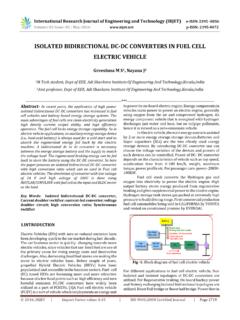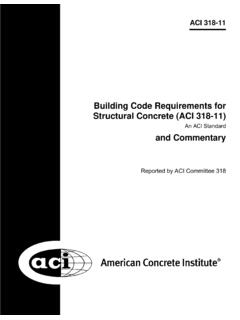Transcription of ANALYSIS, DESIGN AND ESTIMATION OF BASEMENT+G+2 ...
1 International Research Journal of Engineering and Technology (IRJET) e-ISSN: 2395 -0056 Volume: 04 Issue: 06 | June -2017 p-ISSN: 2395-0072 2017, IRJET | Impact Factor value: | ISO 9001:2008 Certified Journal | Page 2074 analysis , DESIGN AND ESTIMATION OF BASEMENT+G+2 RESIDENTIAL BUILDING , Manoj. N. Pai2, N. Pawan2, 1 Assistant professor, Civil Department, KLS Gogte Institute of Technology, Belagavi, Karnataka, India 2 Bachelore of Engineering student, KLS Gogte Institute of Technology, Belagavi, Karnataka, India ---------------------------------------- -----------------------------**--------- ---------------------------------------- --------------------Abstract - structural analysis is a branch which involves determination of behavior of structures in order to predict the responses of real structures such as buildings, bridges, trusses etc, with economy, elegance, serviceability and durability of structure.
2 structural engineers are facing the challenge of striving for the most efficient and economical DESIGN with accuracy in solution, while ensuring that the final DESIGN of a building must be serviceable for its intended function over its DESIGN lifetime. This project attempts to understand the structural behavior of various components in the multi-storied building. analysis , designing and ESTIMATION of multi-storied building has been taken up for BASEMENT+G+2 Building, thereby depending on the suitability of plan, layout of beams and positions of columns are fixed. Dead loads are calculated based on material properties and live loads are considered according to the code IS875-part 2, footings are designed based on safe bearing capacity of soil. For the DESIGN of columns and beams frame analysis is done by limit state method to know the moments they are acted upon. Slab designing is done depending upon the type of slab (one way or two way), end conditions and the loading.
3 From the slabs the loads are transferred to the beams, thereafter the loads from the beams are taken up by the columns and then to footing finally the section is checked for the components manually and using ETABS software for the post analysis of structure, maximum shear force, bending moment and maximum storey displacement are computed. The quantitative ESTIMATION has been worked out. Key Words: NBC, ETABS, Multi-storied Building, Isolated Footing, Open Newel Quarter Turn Staircase, ESTIMATION . 1. INTRODUCTION structural analysis means determination of the general shape and all the specific dimensions of a particular structure so that it will perform the function for which it is created and will safely withstand the influences which will act on it throughout its useful life. Due to concentration and increase of population into urban cities, there is a need to accommodate the influx in urban cities.
4 However, due to rapid increase of land cost and limited availability of land, constructions of Multi storied buildings is taking part in our daily life. A multi- storied is a building that has multiple floors above ground in the building. Multi storied buildings aim to increase the floor area of the building without increasing the area of the land, the building is built on and hence saving land and in most cases money (depending on material used and land prices in the area). The DESIGN process of multi storied building requires not only imagination and conceptual thinking but also sound knowledge of science of structural engineering [1]. In the present study BASEMENT+G+2 building is considered for the analysis of building using ETABS software The project deals with the planning and designing of building of reinforced concrete framed structure using IS 456:2000 code. IS 456:2000 is the basic code for general construction in concrete structures , hence all the structural members are designed using limit state method in accordance with the IS 456:2000 code.
5 The planning of any building in India will recognized by national building code (NBC) [1]. Hence the building is planned in accordance with the NBC. Load consideration is in accordance with IS 875-part2. modeling of the building is done in ETABS and is analyzed to get the deformation, bending moment, shear force and area of steel requirement. structural members like slab, beam, column and footing are designed manually based on the values of bending moment and shear force obtained. 2. LITERATURE REVIEW M. Mallikarjun, Dr P V Surya Prakash (2016): Carried study on analysis and DESIGN of a multi-storied residential building of ung-2+G+10 by using most economical column method and the dead load and live load was applied on the various structural component like slabs, beams and found that as the study is carried using most economical column method this was achieved by reducing the size of columns at top floors as load was more at the bottom floor.
6 The economizing was done by means of column orientation in longer span in longer direction as it will reduce the amount of bending and the area of steel was also reduced [3]. Chandurkar et al (2013): Had presented study of G+9 building having three meters height for each storey. The whole building DESIGN had carried out according to IS code for seismic resistant DESIGN and the building had considered fixed at base. structural element for DESIGN had assumed as square or rectangular in section. They had done modeling of building using ETAB software in that four different models were studied with different positioning of shear walls [5]. International Research Journal of Engineering and Technology (IRJET) e-ISSN: 2395 -0056 Volume: 04 Issue: 06 | June -2017 p-ISSN: 2395-0072 2017, IRJET | Impact Factor value: | ISO 9001:2008 Certified Journal | Page 2075 Ismail Sab, Prof.
7 Hashmi (2014): Generated 3D analytical model of twelve storied buildings for different buildings Models and analyzed using structural analysis tool ETABS. To study the effect of infill, ground soft, bare frame and models with ground soft having concrete core wall and shear walls and concrete bracings at different positions during earthquake; seismic analysis using both linear static, linear dynamic (response spectrum method) has been performed. The analytical model of the building includes all important components that influence the mass, strength, stiffness and deformability of the structure [7]. 3. METHODOLOGY 4. BUILDING DATA FOR analysis Salient Features Utility of Building : Residential Building Area of the site: 70 X 60 (ft) Building Height: 47 ft Number of Storey: ( BASEMENT+G+2 ) Type of construction : Framed Structure Shape of Building :Rectangular Number of staircase: one Number of Lift: One Type of Walls : Brick Wall Dimensions Of Beams B1 230x300 mm B2 230x380 mm Dimensions of Column C1 230x380 mm C2 230x460 mm C3 230x600 mm Thickness of Slab (140mm) Thickness of External Wall 9 (230mm) Thickness of Internal Wall 5 (120mm) (as per IS:875 part2) Live Load Floor Finish All rooms and Kitchen Toilet and Bathroom Corridor, Staircase and Balcony 2kN/m2 2kN/m2 3N/m2 Collection of data Planning Drawing analysis ESTIMATION AUTOCAD Bending Moment Shear Force Designing Slabs Beams Columns Footing Staircase International Research Journal of Engineering and Technology (IRJET) e-ISSN.
8 2395 -0056 Volume: 04 Issue: 06 | June -2017 p-ISSN: 2395-0072 2017, IRJET | Impact Factor value: | ISO 9001:2008 Certified Journal | Page 2076 5. analysis AND DESIGN OF BASEMENT + G + 2 BUILDING USING ETABS Step - 1: Step by Step procedure for ETABS analysis The procedure carried out for modeling and analyzing the structure involves the following flow chart. Step - 2: Creation of Grid points & Generation of structure After getting opened with ETABS we select a new model and a window appears where we had entered the grid dimensions and story dimensions of our building. Here itself we had generated our 3D structure by specifying the building details in the following window. Step - 3: Defining of property Here we had first defined the material property by selecting define menu, material properties.
9 We add new material for our structural components (beams, columns, slabs) by giving the specified details in defining. After that we define section size by selecting frame sections as shown below & added the required section for beams, columns etc. Step - 4: Assigning of Property After defining the property we draw the structural components using command menu Draw line for beam for beams and create columns in region for columns by which property assigning is completed for beams and columns. Step - 5: Assigning of Supports By keeping the selection at the base of the structure and selecting all the columns we assigned supports by going to assign menu, joint\frame, Restraints (supports), fixed. Step - 6: Defining of loads The loads in ETABS are defined as using static load cases command in define menu Step - 7: Assigning of Dead loads After defining all the loads dead loads are assigned for external walls, internal walls Step - 8: Assigning of Live loads Live loads are assigned for the entire structure including floor finishing.
10 Step - 11: Assigning of load combinations Load combinations is based on IS 875 1987 PART 5 using load combinations command in define menu Step - 12: analysis After the completion of all the above steps we have performed the analysis and checked for errors. Step - 13: DESIGN After the completion of analysis we had performed concrete DESIGN on the structure as per IS 456:2000. For this go to DESIGN menu, concrete DESIGN , select DESIGN combo. After this again goes to DESIGN menu, concrete frame DESIGN , start DESIGN \ check of structure then ETABS performs the DESIGN for every structural element. Plan of the Building Fig-1: Plan of the building Fig-2: 3-D View of Frames and Slabs DESIGN of structural components Slabs Slab is plate elements forming floor and roofs of buildings carrying distributed loads primarily by flexure. A concrete slab is common structural element of modern buildings. Horizontal slabs of steel reinforced concrete, typically between 4 and 20 inches (100 and 500 mm) thick, are most often used to construct floors and ceilings, while thinner slabs are also used for exterior paving.














